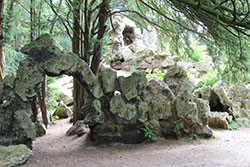
As a result of its popularity, the rockwork has suffered wear and tear to the extent that the mound is currently fenced off to ensure the safety of Elvaston’s visitors.
Today it is of historical significance falling within the boundary of the Elvaston Castle Estate, which is registered as Grade II* on English Heritage’s Register of Historic Parks and Gardens. The mound itself is currently listed as a Grade II structure.
If, in the mid to late 1800s, you had looked across the lake from the castle to the far north shore, you would have had a clear view of what was then known as the Holy Land.
This had no religious significance, but was the name given to the rock work folly erected around 1839 and made to resemble a ruined castle, parts of which still remain today.
Constructed from many thousands of tons of stone, the folly is formed generally from common sand or gritstone, gypsum and tufa (pronounced 'toofa' – a petrified limestone and plant material, found locally in the Matlock area of Derbyshire).
The ruined castle folly was described as "entirely a work of art" (Gardens of England by Aveno Brooke 1858) and the associated ornamental lake was described by many as "like a glimpse of fairyland".
Indeed, when the great Duke of Wellington first saw the rock work on a visit to Elvaston, he was heard to comment:
"This is the only natural artificial rock work I have ever seen!"
Several large yews and cedars of Lebanon were transplanted and removed distances varying from 4 to 40 miles to complete the effect.
Recently, through the process of Dendrology, the cedar tree that sadly no longer stands at the top of the mound (felled May 2013) was approximately dated to be 180 years old.
Since the 1970s, the mound has sadly suffered as a result of its popularity. Heavy use has taken its toll on the trees planted on and around it and the rock work is beginning to show signs of excessive wear and tear.
To try and preserve its historic significance and slow its decline, we would encourage people to play elsewhere, leaving the mound and rock work intact for future generations to see and enjoy.